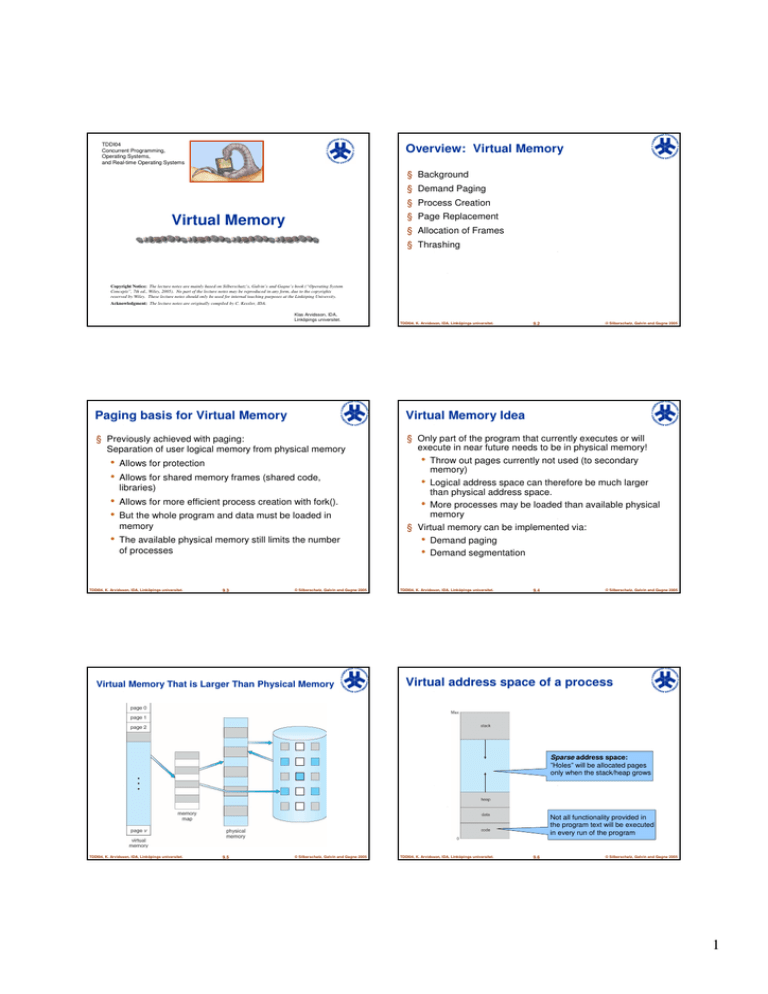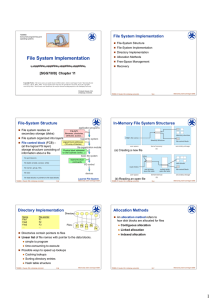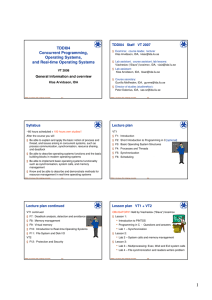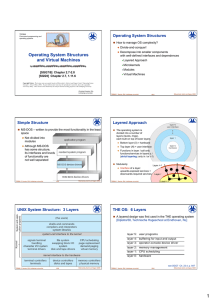Virtual Memory Overview: Virtual Memory § Background
advertisement

TDDI04 Concurrent Programming, Operating Systems, and Real-time Operating Systems Overview: Virtual Memory § Background § Demand Paging § Process Creation § Page Replacement Virtual Memory § Allocation of Frames § Thrashing Copyright Notice: The lecture notes are mainly based on Silberschatz’s, Galvin’s and Gagne’s book (“Operating System Concepts”, 7th ed., Wiley, 2005). No part of the lecture notes may be reproduced in any form, due to the copyrights reserved by Wiley. These lecture notes should only be used for internal teaching purposes at the Linköping University. Acknowledgment: The lecture notes are originally compiled by C. Kessler, IDA. Klas Arvidsson, IDA, Linköpings universitet. TDDI04, K. Arvidsson, IDA, Linköpings universitet. 9.2 © Silberschatz, Galvin and Gagne 2005 Paging basis for Virtual Memory Virtual Memory Idea § Previously achieved with paging: Separation of user logical memory from physical memory § Only part of the program that currently executes or will execute in near future needs to be in physical memory! • Throw out pages currently not used (to secondary memory) • Logical address space can therefore be much larger than physical address space. • More processes may be loaded than available physical memory § Virtual memory can be implemented via: • • Allows for protection • • Allows for more efficient process creation with fork(). • The available physical memory still limits the number of processes Allows for shared memory frames (shared code, libraries) But the whole program and data must be loaded in memory TDDI04, K. Arvidsson, IDA, Linköpings universitet. 9.3 © Silberschatz, Galvin and Gagne 2005 Virtual Memory That is Larger Than Physical Memory • • Demand paging Demand segmentation TDDI04, K. Arvidsson, IDA, Linköpings universitet. 9.4 © Silberschatz, Galvin and Gagne 2005 Virtual address space of a process Sparse address space: ”Holes” will be allocated pages only when the stack/heap grows ⇒ Not all functionality provided in the program text will be executed in every run of the program TDDI04, K. Arvidsson, IDA, Linköpings universitet. 9.5 © Silberschatz, Galvin and Gagne 2005 TDDI04, K. Arvidsson, IDA, Linköpings universitet. 9.6 © Silberschatz, Galvin and Gagne 2005 1 Demand Paging [Kilburn et al. 1961] Demand paging (“lazy paging”, “lazy swapping”): Transfer of a Paged Memory to Contiguous Disk Space § Bring a page into memory only when it is needed • • • • Less I/O needed Less memory needed Faster response More users § A page is needed when a reference to it is made • • invalid reference ⇒ abort not-in-memory ⇒ bring to memory Rather than swap in and out entire processes (cf. swapping) like this we can page in and out individual pages from/to disk. TDDI04, K. Arvidsson, IDA, Linköpings universitet. © Silberschatz, Galvin and Gagne 2005 9.7 Valid-Invalid Bit TDDI04, K. Arvidsson, IDA, Linköpings universitet. 9.8 © Silberschatz, Galvin and Gagne 2005 Page Table When Some Pages Are Not in Main Memory § With each page table entry, a valid–invalid bit is associated (1 ⇒ in-memory, 0 ⇒ not-in-memory) § Initially, valid–invalid bit is set to 0 on all entries § Example of a page table snapshot: Frame # valid-invalid bit 1 1 1 1 0 Μ 0 0 page table § During address translation, if valid–invalid bit in page table entry is 0 ⇒ page fault TDDI04, K. Arvidsson, IDA, Linköpings universitet. © Silberschatz, Galvin and Gagne 2005 9.9 Steps in Handling a Page Fault TDDI04, K. Arvidsson, IDA, Linköpings universitet. 9.10 © Silberschatz, Galvin and Gagne 2005 What happens if there is no free frame? (Case: a free frame exists) § Page replacement – find some page in memory, but not really in use, swap it out • • Write back only necessary if victim page was modified • Algorithms: FIFO, OPT, LRU, LFU etc • Page-buffering: keep a pool of available pages Same page may be brought in/out of memory several times > Goal: minimize the number of page faults > Performance: no need to wait for write-out ”Busy waiting” for slow disk? May allocate CPU to some other ready process in the meanwhile… TDDI04, K. Arvidsson, IDA, Linköpings universitet. 9.11 © Silberschatz, Galvin and Gagne 2005 TDDI04, K. Arvidsson, IDA, Linköpings universitet. 9.12 © Silberschatz, Galvin and Gagne 2005 2 Performance of Demand Paging Demand Paging Example § Page Fault Rate p 0 ≤ p ≤ 1.0 • if p = 0: no page faults § Write-back rate w 0 <= w <= 1 % of page faults where page replacement is needed and the victim page has been modified so it needs to be swapped out • if p = 1, every reference is a fault § Memory access time t § Example: • • • § Effective Access Time (EAT) EAT = (1 – p) t + p . ( page fault overhead + [swap page out] Write-back rate w = 0.5 = 50% EAT = (1 – p) . 1µs + p (15,000 µs) = 1 µs + p . 14999 µs © Silberschatz, Galvin and Gagne 2005 9.13 Time for swapping a page = 10 ms = 10,000 µs expected swap time per page fault = (1+w) * 10,000 µs + swap page in + restart overhead +t ) TDDI04, K. Arvidsson, IDA, Linköpings universitet. Memory access time = 1 microsecond (µs) TDDI04, K. Arvidsson, IDA, Linköpings universitet. 9.14 © Silberschatz, Galvin and Gagne 2005 Process Creation: Copy-on-Write Copy-on-Write § fork(): Child process gets a copy of parent process’ address space § Copy-on-Write (COW) allows both parent and child processes to initially share the same pages in memory § Lazy copying Process 2 writes to page C • If either process modifies a shared page, only then is the page copied • • Free pages are allocated from a pool of zeroed-out pages • No improvement if child process does exec (overwrites all) More efficient process creation as only modified pages are copied § Alternatively: vfork() in Unix, Solaris, Linux: • copy of C TDDI04, K. Arvidsson, IDA, Linköpings universitet. 9.15 © Silberschatz, Galvin and Gagne 2005 Example: Need For Page Replacement Light-weight fork variant: sleeping parent and immediate exec() by child process TDDI04, K. Arvidsson, IDA, Linköpings universitet. 9.16 © Silberschatz, Galvin and Gagne 2005 Page Replacement § Prevent over-allocation of memory by modifying page-fault service routine to include page replacement § Use modify (dirty) bit to reduce overhead of page transfers – only modified pages are written to disk Executes instruktion using data from page 3 TDDI04, K. Arvidsson, IDA, Linköpings universitet. § Page replacement completes separation between logical memory and physical memory – large virtual memory can be provided on a smaller physical memory 9.17 © Silberschatz, Galvin and Gagne 2005 TDDI04, K. Arvidsson, IDA, Linköpings universitet. 9.18 © Silberschatz, Galvin and Gagne 2005 3 How to compare algorithms for page replacement? Basic Page Replacement Extended page-fault service routine: § Find the location of the desired page on disk § Goal: find algorithm with lowest page-fault rate. 1. Find a free frame: § Method: Simulation. • Assume initially empty page table • Run algorithm on a particular string of memory references (reference string – page numbers only) • Count number of page faults on that string. • • If there is a free frame, use it If there is no free frame, use a page replacement algorithm to select a victim frame and, if dirty, write its page to disk 2. Change the written page status to invalid § In all our examples, the reference string is 1, 2, 3, 4, 1, 2, 5, 1, 2, 3, 4, 5. 3. Read the desired page into the (newly) free frame 4. Update the page table and restart the interrupted process TDDI04, K. Arvidsson, IDA, Linköpings universitet. © Silberschatz, Galvin and Gagne 2005 9.19 TDDI04, K. Arvidsson, IDA, Linköpings universitet. 9.20 © Silberschatz, Galvin and Gagne 2005 Expected Graph of Page Faults Versus Number of Frames First-In-First-Out (FIFO) Algorithm § Use a time stamp or a queue § Victim is the ”oldest page” § Assume a memory with 3 physical frames (3 pages can be in physical memory at each point in time) and reference string (page access order): 1, 2, 1 3, 4, 1, 2, 5, 1, 2, 3, 4, 5 1 1 4 4 4 5 5 5 5 5 5 2 2 2 1 1 1 1 1 3 3 3 3 3 3 2 2 2 2 2 4 4 After page 3 is loaded, page 1 is the oldest of them all (gray box) A total of 9 page faults The fact that we re-use an existing page does not alter who has been in there the longest... TDDI04, K. Arvidsson, IDA, Linköpings universitet. Generally, more frames => Less page faults ? © Silberschatz, Galvin and Gagne 2005 9.21 Same FIFO: More frames = better ? TDDI04, K. Arvidsson, IDA, Linköpings universitet. 9.22 © Silberschatz, Galvin and Gagne 2005 FIFO illustrating Belady’s Anomaly § 4 frames (4 pages can be in memory at a time) § Reference string: 1, 2, 1 3, 4, 1, 2, 5, 1, 2, 3, 4, 5 1 1 1 1 1 5 5 5 5 4 4 2 2 2 2 2 2 1 1 1 1 5 3 3 3 3 3 3 2 2 2 2 4 4 4 4 4 4 3 3 3 A total of 10 page faults § FIFO Replacement – Belady’s Anomaly • more page faults despite more frames – possible! more frames but more page faults TDDI04, K. Arvidsson, IDA, Linköpings universitet. 9.23 © Silberschatz, Galvin and Gagne 2005 TDDI04, K. Arvidsson, IDA, Linköpings universitet. 9.24 © Silberschatz, Galvin and Gagne 2005 4 An Optimal Algorithm [Belady 1966] § ”optimal”: • • § Optimal algorithm not feasible? ....try using recent history as approximation of the future! has the lowest possible page-fault rate, does not suffer from Belady’s anomaly § Algorithm: § Algorithm: • • Least Recently Used (LRU) Algorithm Replace page that will not be used for longest period of time.... • Replace the page that has not been used for the longest period of time How do you know this? § Example: § Example: 1, 2, 3, 4, 1, 2, 5, 1, 2, 3, 4, 5 1 1 1 1 1 1 1 1 1 1 4 1 2 2 2 2 2 2 2 2 2 2 2 3 3 3 3 3 3 3 3 3 3 4 4 4 5 5 5 5 5 5 Theoretical algorithm! Used for measuring how well your algorithm performs, e.g., ”is it within 12% from the optimal?” TDDI04, K. Arvidsson, IDA, Linköpings universitet. 1, 2, 3, 4, 1, 2, 5, 1, 2, 3, 4, 5 1 A total of 6 page faults 1 1 1 1 1 1 1 1 1 1 5 2 2 2 2 2 2 2 2 2 2 2 3 3 3 3 5 5 5 5 4 4 4 4 4 4 4 4 3 3 3 Out of pages 1,2,3 and 4, page 3 is the one not used for the longest time... We will need frames 1, 2 and 3 before we need frame 4 again, thus throw it out! 9.25 © Silberschatz, Galvin and Gagne 2005 TDDI04, K. Arvidsson, IDA, Linköpings universitet. 9.26 LRU Algorithm Implementations LRU Approximation Algorithms § Timestamp implementation • The process maintains a logical clock (counter for number of memory accesses made) Overhead! • Every page entry has a timestamp field • Every time a page is referenced, Linear search! copy the logical clock into the timestamp field • When a page needs to be replaced, search for oldest timestamp § Reference bit for each page • Initially = 0 (by OS) • When page is referenced, bit set to 1 • Replace a page whose bit is 0 (if one exists). • We do not know the access order, but unused pages. • May improve precision by using several bits. § Stack implementation • keep a stack of page numbers in doubly linked form: • page referenced: > move it to the top > requires 6 pointers to be changed • No search for replacement TDDI04, K. Arvidsson, IDA, Linköpings universitet. 9.27 A total of 8 page faults © Silberschatz, Galvin and Gagne 2005 § Second chance algorithm • Clockwise replacement • If page to be replaced (in clock order) has reference bit = 1 then: > set reference bit 0 > leave page in memory > replace next page (in clock order), subject to same rules © Silberschatz, Galvin and Gagne 2005 Counting Algorithms TDDI04, K. Arvidsson, IDA, Linköpings universitet. 9.28 © Silberschatz, Galvin and Gagne 2005 Allocation of Frames § Keep a counter of the number of references that have been made to each page § Each process needs a minimum number of pages • § LFU Algorithm: replaces page with smallest count Example: IBM 370 – 6 pages to handle SS MOVE instruction: > instruction is 6 bytes, might span 2 pages > 2 pages to handle from § MFU Algorithm: based on the argument that the page with the smallest count was probably just brought in and has yet to be used > 2 pages to handle to § Two major allocation schemes • • § Not common in today’s operating systems TDDI04, K. Arvidsson, IDA, Linköpings universitet. 9.29 © Silberschatz, Galvin and Gagne 2005 fixed allocation priority allocation TDDI04, K. Arvidsson, IDA, Linköpings universitet. 9.30 © Silberschatz, Galvin and Gagne 2005 5 Fixed Allocation Priority Allocation § Equal allocation • Example: if there are 100 frames and 5 processes, give each process 20 frames. § Use a proportional allocation scheme using priorities rather than size § If process Pi generates a page fault, § Proportional allocation • Allocate according to the size of process si = size of process pi m = 64 s1 = 10 S = ∑ si m = total number of frames ai = allocation for pi = • • si ×m S TDDI04, K. Arvidsson, IDA, Linköpings universitet. 9.31 select for replacement one of its frames or select for replacement a frame from a process with lower priority s2 = 127 10 × 64 ≈ 5 137 127 a2 = × 64 ≈ 59 137 a1 = © Silberschatz, Galvin and Gagne 2005 Global vs. Local Allocation TDDI04, K. Arvidsson, IDA, Linköpings universitet. © Silberschatz, Galvin and Gagne 2005 9.32 Thrashing § Global replacement • process selects a replacement frame from the set of all frames; • one process can take a frame from another § Local replacement • each process selects from only its own set of allocated frames § If a process does not have “enough” pages, the page-fault rate is very high. This leads to: • low CPU utilization • operating system thinks that it needs to increase the degree of multiprogramming • another process added to the system § Thrashing ≡ a process is busy swapping pages in and out TDDI04, K. Arvidsson, IDA, Linköpings universitet. 9.33 © Silberschatz, Galvin and Gagne 2005 TDDI04, K. Arvidsson, IDA, Linköpings universitet. 9.34 Working-Set Model Demand Paging and Thrashing © Silberschatz, Galvin and Gagne 2005 [Denning, 1968] § Why does demand paging work? Locality model • Locality = set of pages that are actively used together • Process migrates from one locality to another • Localities may overlap § ∆ ≡ working-set window ≡ a fixed number of page references § WSi = WSi (t) = working set of process Pi at current time t = set of pages referenced in the most recent ∆ accesses WS can be derived e.g. by simulation, • if ∆ too small, WS will not encompass entire locality by sampling or tracing (with hard• if ∆ too large, WS will encompass several localities ware support). • if ∆ = ∞ ⇒ WS will encompass entire program § WSSi = |WSi| = working set size of process Pi at current time = total number of pages referenced in the most recent ∆ accesses § Why does thrashing occur? Σ sizes of localities > total memory size TDDI04, K. Arvidsson, IDA, Linköpings universitet. § D = Σi WSSi ≡ total demand frames • • 9.35 © Silberschatz, Galvin and Gagne 2005 if D > m ⇒ Thrashing Policy: if D > m, then suspend one of the processes TDDI04, K. Arvidsson, IDA, Linköpings universitet. 9.36 © Silberschatz, Galvin and Gagne 2005 6 Program Structure Matters! Memory-Mapped Files j § Example: Matrix initialization • int data [128][128]; i > Each row is stored in one page .... • • Assume page size = 128 ints Assume < 128 frames available, LRU repl. § Program 1: for (j = 0; j <128; j++) for (i = 0; i < 128; i++) data[i][j] = 0; // traverse column-wise -> 128 x 128 = 16,384 page faults § Program 2: for (i = 0; i < 128; i++) for (j = 0; j < 128; j++) data[i][j] = 0; // traverse row-wise Data access -> 128 page faults TDDI04, K. Arvidsson, IDA, Linköpings universitet. 9.37 locality is an important issue for programmers and optimizing compilers © Silberschatz, Galvin and Gagne 2005 § Memory-mapped file I/O allows file I/O to be treated as routine memory access by mapping a disk block to a page in memory § A file is initially read using demand paging. A page-sized portion of the file is read from the file system into a physical page. Subsequent reads/writes to/from the file are treated as ordinary memory accesses. § Simplifies file access by treating file I/O through memory rather than read() / write() system calls § Also allows several processes to map the same file allowing the pages in memory to be shared TDDI04, K. Arvidsson, IDA, Linköpings universitet. 9.38 © Silberschatz, Galvin and Gagne 2005 TDDI04 Concurrent Programming, Operating Systems, and Real-time Operating Systems Other Issues – I/O interlock § I/O Interlock – Pages must sometimes be locked in memory Additional Slides on Virtual Memory § Consider I/O. Pages that are used for copying a file from a device must be locked from being selected for eviction by a page replacement algorithm. Copyright Notice: The lecture notes are mainly based on Silberschatz’s, Galvin’s and Gagne’s book (“Operating System Concepts”, 7th ed., Wiley, 2005). No part of the lecture notes may be reproduced in any form, due to the copyrights reserved by Wiley. These lecture notes should only be used for internal teaching purposes at the Linköping University. Acknowledgment: The lecture notes are originally compiled by C. Kessler, IDA. TDDI04, K. Arvidsson, IDA, Linköpings universitet. 9.39 Klas Arvidsson, IDA, Linköpings universitet. © Silberschatz, Galvin and Gagne 2005 Data used by Page Replacement Algorithms § All algorithms need extra data in the page table, e.g., one or several of the following: • • A reference bit to mark if the page has been used • • Additional mark bits • A queue or stack of page numbers... Page-Fault Frequency Scheme § Establish “acceptable” page-fault rate • • If actual rate too low, process loses frame If actual rate too high, process gains frame a modify (dirty) bit to mark if a page has been written to (changed) since last fetched from SM Counters or time stamps (used for theoretical algorithms – must often be converted into use of mark bits) TDDI04, K. Arvidsson, IDA, Linköpings universitet. 9.41 © Silberschatz, Galvin and Gagne 2005 TDDI04, K. Arvidsson, IDA, Linköpings universitet. 9.42 © Silberschatz, Galvin and Gagne 2005 7 Other Issues – Prepaging Other Issues – Page Size § Prepaging § Page size selection must take into consideration: • To reduce the large number of page faults that occurs at process startup • Prepage all or some of the pages a process will need, before they are referenced • But if prepaged pages are unused, I/O and memory was wasted • Assume s pages are prepaged and α of the pages is used • • • • fragmentation table size I/O overhead locality > Is cost of s * α saved page faults > or < than the cost of prepaging s * (1 – α) unnecessary pages? > α near zero ⇒ prepaging loses TDDI04, K. Arvidsson, IDA, Linköpings universitet. 9.43 © Silberschatz, Galvin and Gagne 2005 TDDI04, K. Arvidsson, IDA, Linköpings universitet. 9.44 © Silberschatz, Galvin and Gagne 2005 Other Issues – TLB Reach § TLB Reach = the amount of memory accessible from the TLB § TLB Reach = (TLB Size) . (Page Size) § Ideally, the working set of each process is stored in the TLB. Otherwise there is a high degree of page faults. § Increase the page size. This may lead to an increase in fragmentation as not all applications require a large page size § Provide Multiple Page Sizes. This allows applications that require larger page sizes the opportunity to use them without an increase in fragmentation. TDDI04, K. Arvidsson, IDA, Linköpings universitet. 9.45 © Silberschatz, Galvin and Gagne 2005 8





